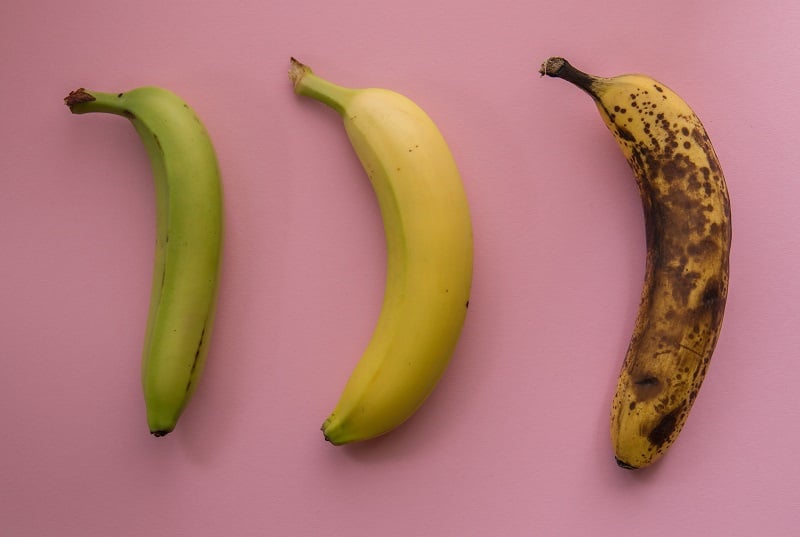Green or Yellow: Which Banana Is Best for Your Health?

Bananas come in all different shades of green, yellow, and brown (representing different stages of the ripening process), but did you know that their nutritional content varies based on their color? What type of banana you enjoy may come down to personal preference, but it’s also good to know what you’re getting in terms of nutrients since the color banana you choose can make a difference in your diet plan.
What is Resistant Starch?
One of the main things to discuss when it comes to bananas is something called “resistant starch.” Resistant starch is a form of carbohydrate. When consumed, it resists digestion in the small intestine and moves on to the large intestine where it ferments and creates healthy prebiotics. Its resistance to digestion helps keep you feeling full for longer periods than other starches, which can spike your blood sugar and leave you feeling hungry rather quickly.
These slow-digesting carbohydrates are a form of soluble fiber and can even help you lose weight by reducing calories absorbed from the foods you eat, providing a feeling of satiety and promoting a well-functioning GI tract. Why is this important when it comes to the common banana? It’s because the levels of resistant starch vary based on the color of banana and can totally change the nutritional value of this popular fruit.
The Stages of a Ripening Banana
So, what is really going on with bananas? Bananas are an interesting food because they start out at one end of the nutritional spectrum and then, over time, make their way to the opposite end. Bananas are part of a group of fruits known as “climacteric” fruits, meaning that when they are exposed to a small amount of the gas ethylene, they will begin to produce more ethylene and start to ripen.
Bananas begin as somewhat bitter with a stiff consistency. As they are exposed to the elements, the ethylene begins to break down the fibers and turn them into sugars, softening the fruit and changing the color of the peel from green to yellow and eventually brown.
Additionally, as the fruit ripens, it becomes sweeter than its green, unripened counterpart as the fibers break down and are converted to sugars.
The Pros and Cons of Green Bananas
It boils down to personal preference, and some folks love green bananas over riper ones. While there are a few downsides, they can get a host of benefits from indulging in these fruits before they hit their ultimate ripeness.
Low glycemic index—Green bananas have a high resistant starch level and thus a low glycemic index. As they ripen, the starches change to sugars, making the nutritional content a high glycemic food. But a green banana is actually so low in sugar that it’s even sometimes listed as a recommended food for diabetics.
High in resistant starch—this means the green bananas are high in insoluble fiber to provide you with a filling snack that won’t break the calorie bank.
Lowest sugar content—a greener banana will be very low in sugars, so if you’re watching your carbs, this is the way to go.
Improved blood sugar—due to the pectins (and, of course, the fiber), green bananas can help keep your blood sugar stable in contrast to the spike you might experience with higher sugar foods.
High in prebiotics—this means a healthy gut and better digestion which can help you boost your immune system and even help your body process and get rid of excess fats and toxins.
Better absorption of some nutrients—the nutrients naturally present in green bananas can help you absorb other vital nutrients as well, like calcium, for example.
Low-FODMAP diet friendly—the green bananas are so low in oligo-fructans that they are allowed on the low-FODMAP diet. FODMAPS are fermentable carbohydrates that can trigger digestive issues in sensitive people. A FODMAP-friendly food is generally considered to be acceptable to those with a host of health issues.
Some of the downsides of green bananas are:
May cause gassiness—a big downside that the unripened fruit may cause: all that fiber may lead to bloating for some people.
Bitterness—green bananas are not known for their sweetness. In fact, they can be borderline bitter and hard with a sometimes strange, waxy feel to them. This combo makes them a less popular alternative for many.
The Pros and Cons of Yellow Bananas
If you aren’t a fan of green bananas, don’t sweat it. Yellow bananas have plenty of positive properties, too, such as providing disease-fighting antioxidants. Plus, they are easy to digest. So, while there are a couple of downsides, just like with the less ripe variety, Team Yellow can still indulge with almost abandon as yellow bananas sport a host of upsides.
Better taste—if you like sweet, then the yellow banana team is for you! Because the fiber has been broken down and converted to sugars, you benefit from the enhanced sweetness of the riper fruit.
LIMITED TIME OFFER: Get Ageless Turmeric, Our Highly-Bioavailable Turmeric & Ginger Supplement, As Low As $14
Better digestion—for those folks who may have a hard time digesting the greener fruits, the good news is they should have no problem with digestion once the fruit turns yellow because the starch/fiber has been converted to simple sugars at this point, and that means easy digestion for most people.
Active disease-fighting properties—according to Japanese scientists, yellow bananas boast what’s known as TNF (Tumor Necrosis Factor), which is a substance that may help your cells fight off abnormal cells. TNF helps boost your white blood cell count and thus support your immune system.
Higher in antioxidants—yes, as they get ripe, bananas actually increase in their antioxidant value. Amazing, but true. These high levels of antioxidants can assist your body in combating free radicals, another potent disease-fighting tool.
Some of the downsides of yellow bananas are:
FODMAP unfriendly—alas, while the green version of the banana is super FODMAP friendly, the ripe variety is absolutely not! High in sugars and oligo-fructans, ripe bananas should be avoided by those following a low-FODMAP diet plan as they can lead to a host of issues for those with sensitive systems.
High in sugars—a possible downside, depending on your dietary goals, would be the higher sugar content of the yellow or even overripe bananas. Because the resistant starch has broken down during the ripening process, you are left with a fruit much higher in sugar content than its less-ripe twin.
Lower vitamins and minerals—the longer you let your banana go, the less impact it will have in terms of vitamins and minerals. So, capturing it somewhere in the middle will give you the best nutritional value.
So, whether you are Team Green or Team Yellow, eating bananas is a great idea. For the most bang for your buck, try eating both ends of the banana spectrum. With a mere 100 calories per medium banana, you just can’t go wrong with this conveniently wrapped healthy and wildly nutritious super snack.




 7 Signs Your Body is Seriously Low on Collagen (not just wrinkles)
7 Signs Your Body is Seriously Low on Collagen (not just wrinkles) Health Expert: "Turmeric Doesn't Work (unless...)"
Health Expert: "Turmeric Doesn't Work (unless...)" 3 Warning Signs Your Probiotic Supplement is a Total Waste
3 Warning Signs Your Probiotic Supplement is a Total Waste

